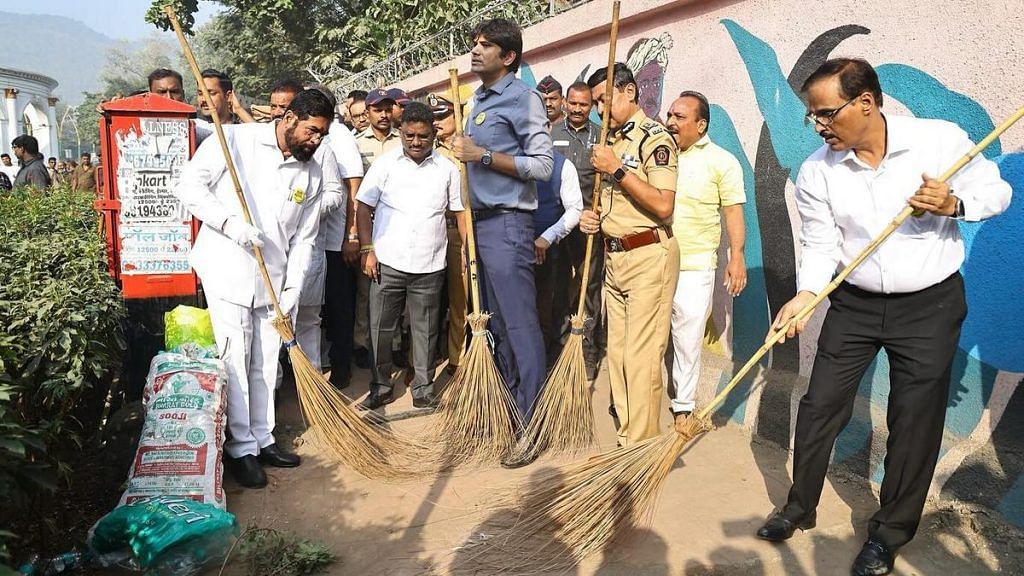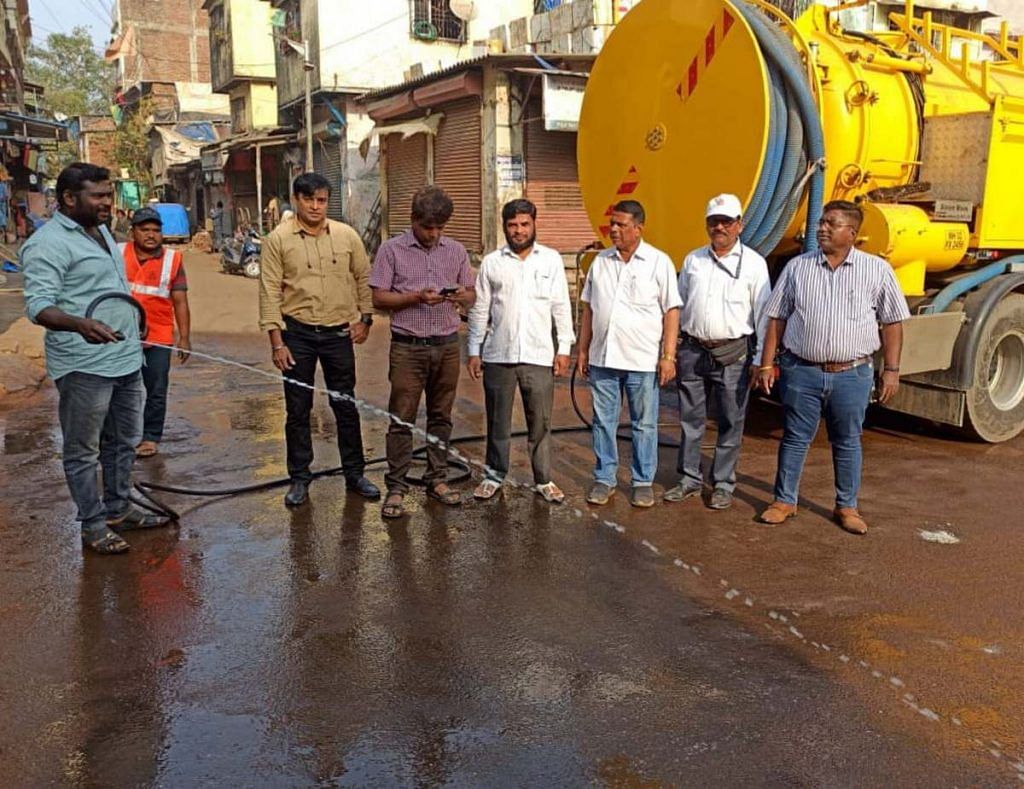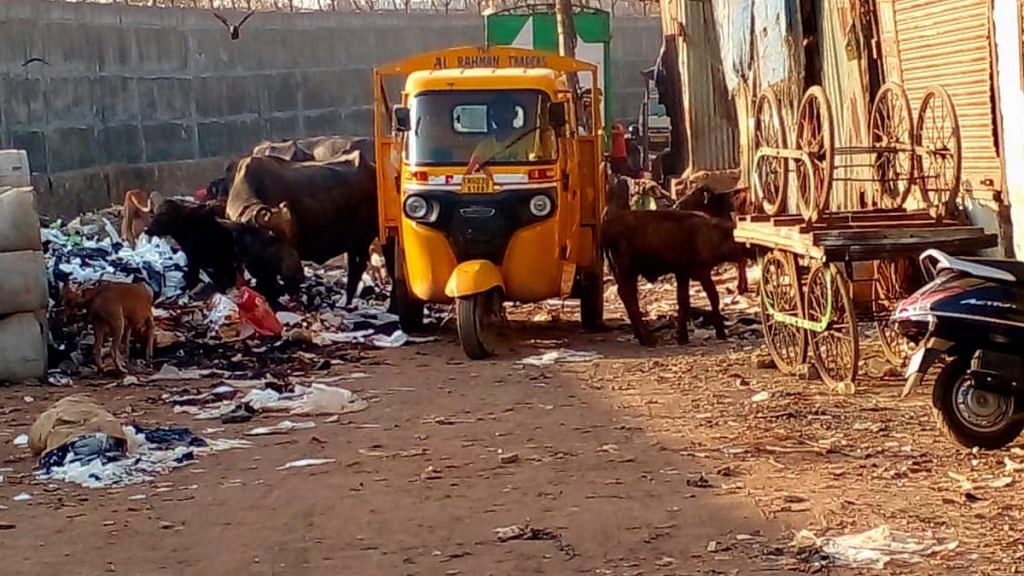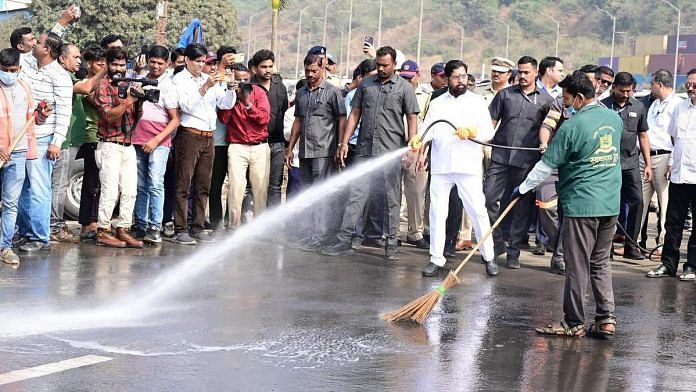Mumbai: A spray nozzle in his gloved hands, Eknath Shinde unleashed a cleansing jet of water on a Sion Dharavi road, later marching over to closely inspect the filthy drainage canal. That was on 3 December, the start of an ambitious Mumbai deep cleaning drive—an attempt to fight rising pollution levels. Diwali had come early to Mumbai.
In the weeks that followed, Shinde along with other leaders, such as Mumbai guardian minister Mangal Prabhat Lodha, visited Byculla Zoo, Govandi, Versova, Hiranandani Complex in Powai, and other parts of the city, urging Mumbaikars to clean up their act. But already, the sea is spewing garbage back on the shores of Girgaon, and the streets of Govandi are filling up with trash and gutter water, despite the Maharashtra government passing on the baton to civic authorities at the ward level. The civic body has set aside Rs 80 crore in its 2024-25 budget for this anti-pollution deep clean.
Across the city, a tale of two Mumbais unfolds. While some areas continue to be spruced up, others languish like forgotten dusty corners.
“They [the government] could not even complete our road as their water in the tanker got over and they left saying they would be back. They still haven’t come back,” said Ayaz Hussain, a resident of Bainganwadi in Govandi, one of the most underdeveloped parts of the city. “People were confused. They had not seen such cleaning before. But now we don’t know when they will come back.”
But at Girgaon Chowpatty, one of South Mumbai’s wealthier neighbourhoods, the civic body has picked up seamlessly from where the Chief Minister left off.
The problem is with the policy—that you are washing the roads on the one hand, while construction activities are being carried out non-stop
-Chandrashekhar Prabhu, urban planner
“It is relatively cleaner now. The beach cleanup marshals are more regular and vigilant about cleanliness,” said Girgaon resident Rucha Joshi who goes for regular walks on the beachfront and in the Malabar Hill area.
The deep clean drive, which has now been extended across Maharashtra, has left everyone confused. For the first eight weeks, it was led by the Shinde government, and since February, work is being carried out by the Brihanmumbai Municipal Corporation (BMC) at the ward level. On weekends, the drives are carried out in areas of every zone with the help of marshals, RWAs, and residents.
The initiative has earned its fair share of critics. Urban planners and civic activists say it is a knee-jerk response to rising pollution levels primarily caused by frenzied construction activity and the resultant grime and dust. And political opponents have written it off as a publicity stunt.
Every weekend in December and January, local media and WhatsApp groups were flooded with photos of Shinde holding brooms, spades, and hoses, flanked by dumpers, compactors, tankers, and tractors. Thousands of civic employees and clean-up marshals across the BMC—from the stormwater drain to the hydraulic department—were roped in for this effort.

“The rising air pollution and the unclean city had to be tackled. And the CM suggested we do deep cleaning. It is like how we clean houses before Diwali, just on a larger and more regular scale,” said assistant municipal commissioner, BMC, Sudhakar Shinde.
The BMC claims to have removed 1,600 tons of debris and 463 tons of garbage. Additionally, 22,277 km of roads were thoroughly washed across all administrative wards.
However, the long-term efficacy of the plan has been questioned, as has the amount of water used, especially when the city may be looking at a 10 per cent water cut this summer. While the BMC recently announced it has scrapped this plan, it has already imposed a 5 per cent water cut across the city until 24 April.
“Why is this being done exactly? To curb the pollution or to clean the road. If it’s only to keep the roads clean, it won’t remain like that. They will automatically become dirty the next day,” said urban planner Chandrashekhar Prabhu. “This can’t be done every day. We don’t have water or other resources to maintain it.”
The cleaning drive operates in a staggered schedule across each of the 25 administrative wards under the BMC. Each ward gets an area-by-area deep clean spread over eight weekends. But this rinse-and-repeat cycle leaves many waiting.
Also Read: Surat’s Swachh sweep—how diamond city went from plague to podium in 30 years
Wake-up call
On its part, the Brihanmumbai Municipal Corporation intends to keep up the momentum. Care is being taken to ensure drinking water is not wasted, it has stated.
The winter of 2023 was a wake-up call for the city when the air quality plummeted, and Mumbai was being compared to landlocked Delhi. As AQI levels rose to 400 and above, the government jumped into action while imposing curbs on construction activity. They washed pavements and roads more than 60 ft wide. Trees were pruned, weeds were removed, paan stains were scrubbed off, and walls along roads were beautified. Fogging machines trundled up and down spraying insecticide, public toilets were cleaned, garbage was removed from storm water drains, and unclaimed vehicles were towed away.
A total of 121 water tankers, along with sludge dewatering machines, fire tankers, and micro water sprayers were rolled out for the project.
In the long run, there have to be policy changes addressing salaries of the staff, increasing the number of employees, having water connection in public toilets, and so on. Just cleaning the road for one day won’t change much
-BMC official
All this will continue, say civic officials, who plan to wash 1,000 km of roads every day, over and above the ward-level deep cleaning exercise. However, the initiative is facing backlash, with reports that on an average 15.49 lakh litres of water are being used per day. Civic officials have clarified that the water being used is not potable, but comes from recycled and local sources like borewells and sewage treatment plants, but detractors claim it’s still not a sustainable solution.

“The problem is with the policy—that you are washing the roads on the one hand, while construction activities are being carried out non-stop,” urban planner Prabhu said. “There has to be a comprehensive policy in place.” He also questioned why sprinklers weren’t used if the goal was to combat pollution.
Meanwhile, even as Shinde extended the program across the state, ward officers in Mumbai are scrambling to keep up the momentum. Even within the BMC, senior officials are doubtful if they can sustain the drive.
“In the long run, there have to be policy changes addressing salaries of the staff, increasing the number of employees, having water connection in public toilets, and so on. These critical policies are needed,” said an assistant commissioner of the BMC, asking to remain anonymous. “Just cleaning the road for one day won’t change much. There have to be behavioural changes among people as well.”
Political opponents have not wasted time criticising the Shinde government either. Former corporator and Samajwadi Party MLA Raes Shaikh alleged that there’s no deep cleaning happening. Keeping Mumbai clean is part of the civic body’s job, he said. “Why is the Chief Minister coming out on the road to clean it? This means there is a failure of the mechanism.”
Also Read: Tunnels, cycling tracks, park — all about Worli-Marine Drive stretch of Mumbai coastal road
Selective benefits?
At the verdant Joggers’ Park in Bandra’s Carter Road, residents such as Govind Narayan are thrilled. The BMC is finally taking their cleanliness complaints seriously and acting fast.
“Post the cleanup in our area, the BMC officials have become more aware and responsible. Earlier, no one would listen to our complaints about the park being unclean. But things changed when the CM told us in front of officials that our complaints will be heard,” he said. “We won that day.”
Narayan’s neighborhood now boasts a cleaner and brighter look, as do pockets of Malabar Hill, Girgaon Chowpatty, and other affluent areas. But this change is not uniform.
At Road Number 14 of Baiganwadi in Govandi, residents survey gutter water spilling onto the roads and piles of garbage collecting at regular intervals.
On 28 January, around 7 am, a team of around 30 BMC workers descended on this road, which was selected as part of the deep cleaning drive. First, they swept it clean. Then they started scrubbing it manually, and finally a battalion of tankers rolled in — three massive ones carrying 10,000 litres of water and two with a capacity of 5,000 litres. And, finally, the area was defogged.
But two weeks later, it’s back to its original state of dirt and decay.

The cleaning drive operates in a staggered schedule across each of the 25 administrative wards under the BMC. Each ward gets an area-by-area deep clean spread over eight weekends. But this rinse-and-repeat cycle leaves many waiting.
Nehal Shah, an ex-corporator of the BJP from Matunga told ThePrint that in her ward, 177- F/North, the deep cleaning exercise was done last Saturday. She will have to wait another nine more Saturdays for her turn.
“Regular sweeping of the road can be done regularly, but deep cleaning is not possible due to lack of staff. Instead of this deep cleaning, creating awareness about cleanliness, especially among hawkers, is important,” said Shah.
At Deonar in West Govandi, resident Faiyyaz Shaikh surveys the garbage and stray cows on the road outside his house, the air ripe with the stench of a nearby gutter. Unchecked construction debris from a recent road project sits at one corner, causing continuous dust pollution. And as if that weren’t enough, the Deonar dumping ground looms large behind his area.
Like other residents of Bhiwandi, he’s waiting for lasting change.
“The condition may have improved in some areas, but not here,” he said. “It is more like a photo-op for leaders. The road remains good for a day when it is done, but the next day, it’s back to its original state.”



